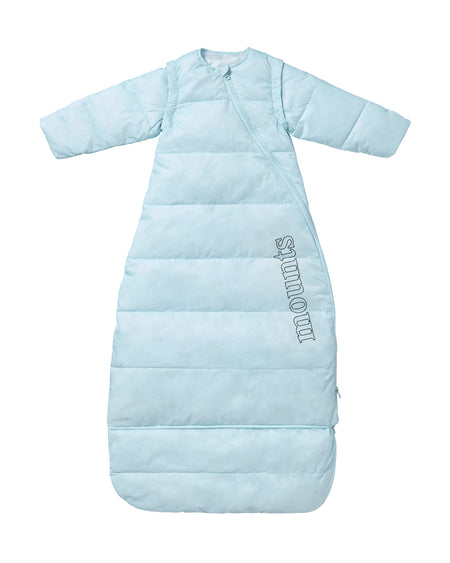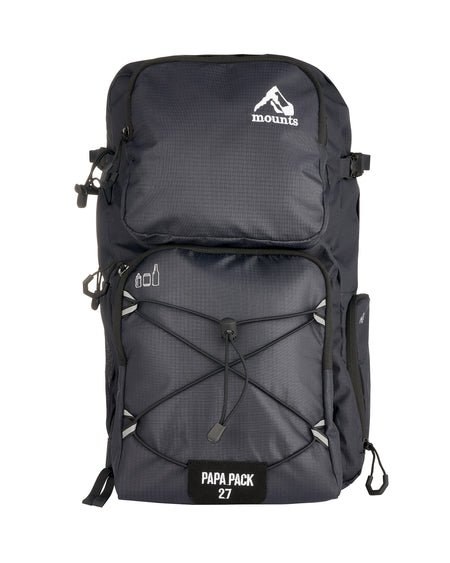You and your child will go through many phases as they grow and develop after birth, from sleeping to not sleeping, crying, teething, feeding, crawling and walking. These phases can lead to many months of sleep deprivation and tiredness. Deciding when and how to get back onto the trail, start achieving new goals or getting back to your old self takes courage and encouragement. We want to try and give you some practical advice that might give you the confidence to go camping with your baby or toddler.
Mounts fully admits that leaving the house with a youngster is a challenge … a walk around the block, full day in nursery, an overnight stay with family or friends, or going on an extended trip requires planning, diligence and more items than you imagined. It is easy to over burden yourself. Plan for a return to the trail by starting from the bottom up: shelter, sleep, water, food, clothing, bathroom, lighting and add from there. Different seasons and ages carry different clothing and bedding needs. Two parent versus one parent introduces large capacity differences for carrying items. The largest challenge will always be carrying the vast amounts of items needed to be responsible, safe and fit in enjoyment.
Once you understand what you want to bring, break down your trip. You will be carrying out a variety of necessary activities. These will range from setting up the tent, unpacking sleeping gear, cooking dinner, gathering water or firewood, or tackling adverse weather conditions. This will be different from when you bathe or cook at home, where you are in a safe environment to carry out these activities. Planning for where your child will be during these necessary outdoor activities will take away the major stress of camping with young children. Juggling your attention between setting up your tent and keeping them away from hazards is stressful, slows things down and leaves less time for enjoyment.
We see roughly five phases of a young child’s development:
Phase 1: Blob
Phase 2: Potted plant
Phase 3: Assisted walker
Phase 4: Confident walker
Phase 5: Independent walker
Each phase has its own considerations and advantages. All children reach phases at different times but in each phase there is a route to start achieving your goals.
 |
It may seem counterintuitive but we believe launching yourself back onto the trail during this phase is the easiest time to do it. As a parent, you are likely to be extremely sleep deprived and the thought of leaving the house may pose a challenge but we urge you to stop and consider. Your child is likely feeding roughly every four hours and sleeping in between feeds. Their source of food may be their mum and they are comfortable sleeping in a variety of environments (bassinet, carrier, pram, bouncer, your arms, loud, quiet, bumpy, dark, light). They are also light enough to support in your arms and your walking carrier will be chest mounted. |
Phase 1 Advantages:
-
If breastfeeding, you don’t need to carry additional food or water. Only Mum needs to be present
-
Both parents are available to carry full-sized backpacks (baby is carried on your chest)
-
The baby is light, not overburdening the parent’s ability to travel distances or carry additional weights
-
The baby will likely feel comfortable in their sleeping conditions
-
The baby is likely unable to find trouble either inside the tent or in the wilderness. Easily monitored and contained
Phase 1 Considerations:
-
The baby is fragile and extra care must be taken
 |
Once reaching phase 2, the parent will hopefully be emerging from a state of extreme sleep deprivation into mild sleep deprivation and feeling more confident about leaving the house. Your child is starting to roll or crawl but likely confined; trying puree foods; transitioning to a bottle; comfortable sleeping in a variety of environments (crib, carrier, pram, bouncer, your arms, loud, quiet, bumpy, dark, light); light enough to support in your arms; walking carrier is still chest mounted at 6 months. |
Phase 2 Advantages:
-
Baby formula is light to carry, depending if there is a water source
-
Store bought puree does not require refrigeration
-
Both parents are available to carry full-sized backpacks (baby carried on chest)
-
The baby is light, not overburdening the parent’s ability to travel distances or carry additional weight
-
The baby will likely feel comfortable in their sleeping conditions
-
The baby is unable to travel far. Easily monitored and contained
Phase 2 Considerations:
-
Baby formula needs sterilized water. Is water available? Can you sterilize it?
-
Long life milk is heavy
-
Rolls around frequently during sleep, needs containment
-
The baby is still fragile and extra care must be taken
-
The baby can find dangerous items inside the tent. Items must be stored
 |
Once reaching phase 3, the parent will hopefully now be starting to get caught up on sleep and have an increased confidence in juggling your child’s needs outside the home. Your child is actively crawling and starting to stand with assistance; moving to solid foods; drinking whole milk and water; napping twice during the day in a variety of environments (crib, pram, loud, quiet, bumpy, dark, light); sleeping during night time in a contained crib in the dark; has transitioned to a backpack style carrier and starting to gain in weight, limiting your ability to transport them over distance. |
Phase 3 Advantages:
-
The toddler is starting to become aware of potential dangers
-
Water is now a larger part of toddler diet. A source may be available on site
-
Store bought puree does not require refrigeration
Phase 3 Considerations:
-
You need a backpack carrier for your child. This reduces the amount of packing space available and may hinder the distance you can travel
-
The baby is actively moving around and needs active monitoring during the day. For sleep, they are starting to move more frequently. They need a contained space for warmth and safety. If they wake before you do, they need to be in a safe environment clean of loose gear.
-
A travel crib may be necessary. These can be bulky and heavy
-
Milk and perishable solid food needs carried and stored correctly
-
The toddler can find dangerous items inside the tent. Items must be stored correctly.
 |
Without good preparation, Phase 4 may be the most difficult opportunity to return to the trail. Your toddler is starting to become very active. They have moved to 1 day nap; they have a solid bedtime routine; they sleep in the dark; they understand food and may be fussy about it; they need a backpack carrier; they are a real weight to carry over distance; and they can get bored easily without activities or attention. |
Phase 4 Advantages:
-
The toddler is starting to become aware of potential dangers and may need less monitoring
-
Water is now a major part of diet. A source may be available on site.
Phase 4 Considerations:
-
You need a backpack carrier for your child. This reduces the amount of packing space available and may hinder the distance you can travel
-
The toddler is starting to become more curious. Activities and entertainment become a large part of the day and they may need constant attention
-
The baby is actively moving around and needs active monitoring during the day. For sleep, they are starting to move more frequently. They need a contained space for warmth and safety. If they wake before you do, they need to be in a safe environment clean of loose gear.
-
A travel crib may be necessary. These can be bulky and heavy
-
Milk and perishable solid food needs to be carried and stored correctly
-
The toddler can find dangerous items inside the tent. Items must be stored correctly.
 |
The challenges of bringing young children camping start to improve when you reach Phase 5. At this stage, your child is becoming accustomed to walking distances unassisted; they are starting to listen to your directions and warnings; they still have a day nap; they have a solid bedtime routine; they sleep in the dark; you have a clear picture of what foods they do and do not eat; their weight is burdensome to carry any distance; and they can get bored easily without activities or attention. |
Phase 5 Advantages:
-
The toddler is starting to become aware of potential dangers and may need less monitoring
-
Water is now a major part of diet. A source may be available on site
-
Milk may be less important and can be removed from a short-term diet
-
The toddler can walk independently, giving back the parent’s ability to carry a full-sized backpack
-
A travel crib may no longer be necessary
Phase 5 Considerations:
-
The toddler is curious. Activities and entertainment become a large part of the day and they may need constant attention
-
The baby is actively moving around and needs active monitoring during the day. For sleep, they are starting to move more frequently. They need a contained space for warmth and safety. If they wake before you do, they need to be in a safe environment clean of loose gear
-
Milk and perishable solid food need to be carried and stored correctly
-
The toddler can find dangerous items inside the tent. Items must be stored correctly






